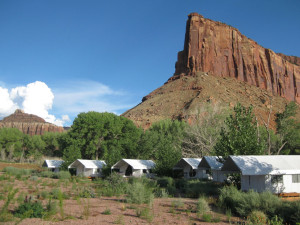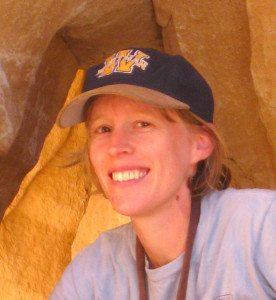By Alice de Anguera for EDRblog.org.
The Canyonlands Research Center (CRC) in Southeast Utah is an excellent case study of collaboration between scientists and land managers. I have been studying this venture for my graduate work at Utah State University. CRC’s mission is to conduct research on land use and climate and help create sustainable land management solutions for arid lands. This is urgent because the red rock country of Southeast Utah is in the bulls’-eye of predicted temperature rise. Now, as I wrap up my project, the current challenge for CRC is to revise, with their partners, what this ambitious collaboration should look like.
The CRC crystallized into its current form in 2009, with a field station at the historic Dugout Ranch northwest of Monticello, Utah. The CRC’s project area covers about 800,000 acres of public lands, including sections of Canyonlands National Park, the Manti-La Sal National Forest, and the Bureau of Land Management’s (BLM) Monticello Field Office. The project is mainly focused on ecological research and seeking answers to questions like, “How will climate change impact the capabilities of our land and water to provide the services we want?” and “How do land management actions affect the future potential of those lands and waters?”
The founding researchers envisioned CRC as a way to provide needed science for land use discussions too often swayed by, well, not science. Researchers from the US Geological Survey, Utah State University, and other universities would conduct studies and transfer results to local land managers (BLM, US Forest Service, and National Park Service) to integrate those data into land management decisions. The Dugout Ranch remains a working ranch, and utilizing those cattle for sustainable grazing research is also part of the plans.
Over the last six years, some exciting research has been done, and more is in the works. Researchers are currently working out how to re-establish critical biological soil crust on a human timeline, testing the adaptability of certain grasses to changing precipitation regimes, studying the success of different genetic varieties of cottonwood tree, and more.
So the research side of things is going well. However, communication among researchers, land managers, and CRC staff has been lacking. CRC’s 2.5 staff members handle everything from running meetings (the group does not have a separate facilitator) and bringing in research projects to maintaining the field station to wrangling cattle. Conversations about research and decisions have not been timed appropriately, plot location data has been hard to get, and most importantly, participants struggle to appreciate others’ perspectives. Land managers have the unenviable job of considering not just scientific data, but also stakeholder interests, political pressures, funding and staff limitations, and other decision-making concerns. Researchers, on the other hand, may find themselves feeling, like Aldo Leopold wrote in his Sand County Almanac: “One of the penalties of an ecological education is that one lives alone in a world of wounds.” Researchers might have information that could help heal some of those wounds, but getting these data to the decision table has been complicated. Collaborative idealism, meet reality.

During my study, I interviewed the head of the Yellowstone Ecological Research Center (YERC), Robert Crabtree, and I keep coming back to something he said. He discovered that best way to work with their land management partner, Yellowstone National Park, involved thinking outside of the standard research model. Research centers usually employ science graduate students to collect data in the field, however, the park already had decades worth of data. What Yellowstone needed was expertise to create useful tools with this data, for example, a way to predict when the bison would leave the park. So YERC and its graduate students responded to this challenge. YERC takes pride in the fact that park representatives now approach the Center with their science needs. YERC shaped their successful collaboration around the needs of their partner.
My report on this project is nearly done, and my recommendations feel like common sense: clarify goals, decide as a group how decisions and conflicts will be handled, and celebrate successes. Implement a system for collecting information from researchers, so that information can be shared with land managers. Create incentives for land managers and researchers to collaborate. Understand that the resulting collaboration might not look like the original vision. Most importantly, take the time to communicate and build relationships.
In early June, Canyonlands Research Center staff visited the Monticello BLM office to present current projects and thoughts on how they might work together. The ‘how’ was pretty vague, but intentionally so. After the presentation, one BLM staff member commented, “we should do a presentation for you, so you can understand our processes.” The CRC response: “Yes, please!” So, in some ways, CRC is just getting started. The idea of scientists and land managers working together to produce useful research and improve land management is powerful, and the partners are committed – they just need to keep chipping away at this, together.
 Alice de Anguera is a graduate student at Utah State University in the Master of Natural Resources program. She lives in Moab, Utah and has worked as a ranger naturalist at both Arches and Canyonlands National Parks.
Alice de Anguera is a graduate student at Utah State University in the Master of Natural Resources program. She lives in Moab, Utah and has worked as a ranger naturalist at both Arches and Canyonlands National Parks.
